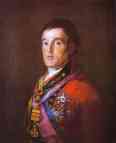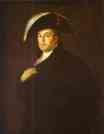Olga's Gallery
During the last fortnight we have published the works of Francisco
de Goya, the greatest Spanish artist. Portraiture was one of Goya's
favorite genres, he left us numerous portraits of his contemporaries, and
among them are 4 portraits of
The Duke of Wellington
 The
only British sitter of the great artist. Two of the portraits are in oil
and 2 are pencil drawings. Of those in oil, one is the large equestrian
portrait (now in Wellington's Museum, Apsley House, London) and another
is the bust portrait from the National Gallery, London. Not all art historians
consider the third widely known painting of Wellington with hat and cloak
(National Gallery, Washington, DC) to be one of Goya's works.
The
only British sitter of the great artist. Two of the portraits are in oil
and 2 are pencil drawings. Of those in oil, one is the large equestrian
portrait (now in Wellington's Museum, Apsley House, London) and another
is the bust portrait from the National Gallery, London. Not all art historians
consider the third widely known painting of Wellington with hat and cloak
(National Gallery, Washington, DC) to be one of Goya's works.
 Of
the two paintings, the bust portrait is thought to be the most likely to
have been painted from life. It was probably executed in August 1812 during
the British commander's short stay in Madrid, at the same time as the equestrian
composition, when Sir Arthur Wellesley was still Earl of Wellington and
Lieutenant General, the chief commander of the British army in the Peninsula.
On this ceremonial portrait Wellington is wearing a full military costume.
Some of the decorations that he wears were received after he left Madrid
in 1812. The alterations are believed to have been made in May 1814, when
Wellington returned to Spain as Ambassador to Ferdinand VII.
Of
the two paintings, the bust portrait is thought to be the most likely to
have been painted from life. It was probably executed in August 1812 during
the British commander's short stay in Madrid, at the same time as the equestrian
composition, when Sir Arthur Wellesley was still Earl of Wellington and
Lieutenant General, the chief commander of the British army in the Peninsula.
On this ceremonial portrait Wellington is wearing a full military costume.
Some of the decorations that he wears were received after he left Madrid
in 1812. The alterations are believed to have been made in May 1814, when
Wellington returned to Spain as Ambassador to Ferdinand VII.
There are so many interesting books and web sites devoted to the Duke
of Wellington that it seems there is nothing else to add, especially in
a short newsletter. We managed to come upon a document, written by Sir
Arthur Wellesley, approximately during the period when he sat for Goya,
which characterizes “the silent, unsmiling” commander, quite unexpectedly,
as a man with a good sense of humor.
Message from Sir Arthur Wellesley, Earl of Wellington, to the British Foreign Office in London, written in Spain, August 1812
Gentlemen,
Whilst marching from Portugal to a position, which commands the approach to Madrid and the French forces, my officers have been diligently complying with your requests, which have been sent by H.M. ship from London to Lisbon and thence by dispatch to our headquarters.
We have enumerated our saddles, bridles, tents and tent poles, and all
manner of sundry items for which His Majesty's Government holds me accountable.
I have dispatched reports on the character, wit, and spleen of every officer.
Each item and every farthing has been accounted for, with two regrettable
exceptions for which I beg your indulgence.
Unfortunately the sum of one shilling and nine pence remains unaccounted
for in one infantry battalion's petty cash and there has been a hideous
confusion as the number of jars of raspberry jam issued to one cavalry
regiment during a sandstorm in western Spain. This reprehensible carelessness
may be related to the pressure of circumstance, since we are war with France,
a fact which may come as a bit of a surprise to you gentlemen in Whitehall.
This brings me to my present purpose, which is to request elucidation of my instructions from His Majesty's Government so that I may better understand why I am dragging an army over these barren plains. I construe that perforce it must be one of two alternative duties, as given below. I shall pursue either one with the best of my ability, but I cannot do both:
1. To train an army of uniformed British clerks in Spain for the benefit of the accountants and copy-boys in London or perchance.
2. To see to it that the forces of Napoleon are driven out of Spain.
Your most obedient servant,
Wellington
The text of the message is sited from this site.
We would be glad to receive your opinions and comments on our newsletters.
Please write to freeart@freeart.com